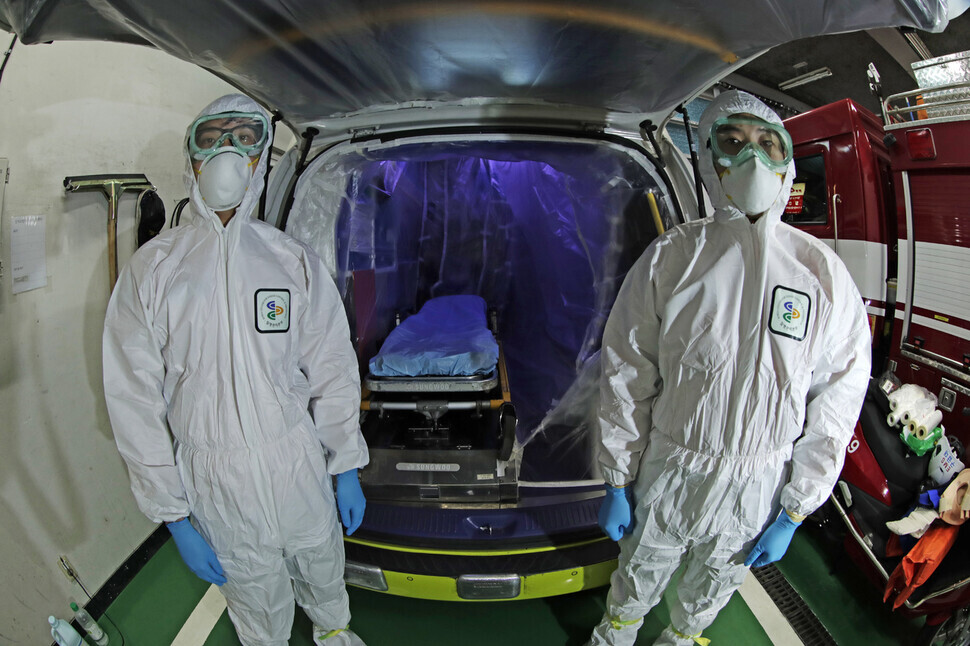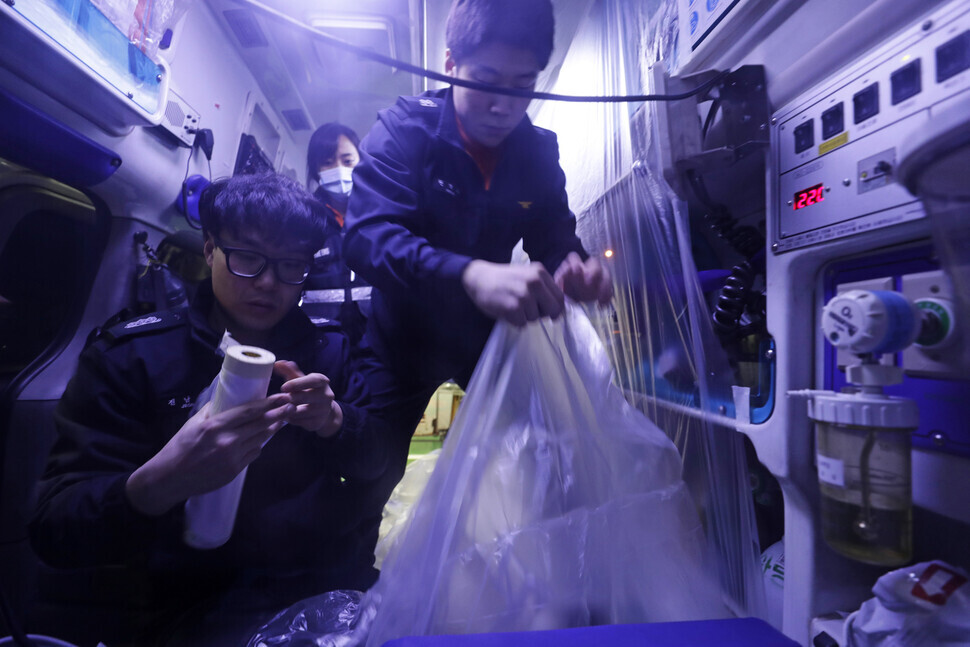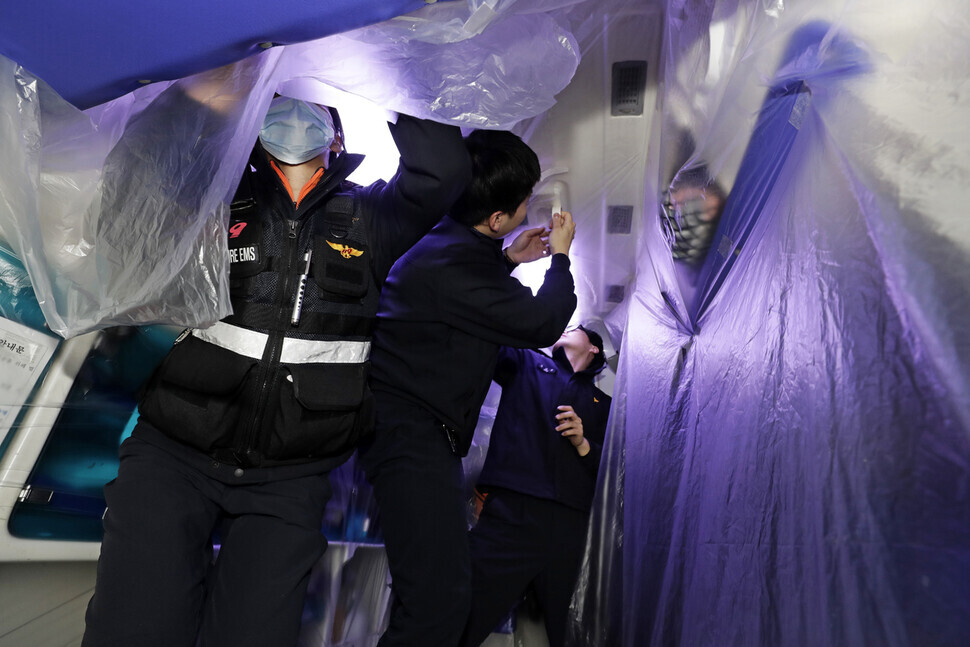hankyoreh
Links to other country sites 다른 나라 사이트 링크
[Reportage] A day in the life of an emergency response worker in the time of COVID-19
Paramedics work for so long without breaks they resort to wearing diapers

“We weren’t allowed to stop the ambulance at a rest area while taking patients from Daegu to Seoul, so the paramedics put on diapers and put them on the patients, too,” said Lee Si-hyung with a bashful expression on his face. Lee, 39, a firefighter with the first response team at Gangseo Fire Department in Seoul, was interviewed by the Hankyoreh on June 9.
Lee has spent the past five months transporting COVID-19 patients. In late January, the patients he was handling were Koreans who’d been flown from Wuhan to Korea on charter planes; in February, they were Koreans returning from a Japanese cruise ship; and in March, they were Koreans repatriated from Iran and people arriving from overseas.
Lee’s most memorable experience on the job was when he volunteered to transport patients from Daegu between Mar. 3 and 9. During his six days on the job, an average of 350 new cases were diagnosed in Daegu each day.
Lee couldn’t say for sure why he’d volunteered for that job without his family’s knowledge. “Most people run away from a fire, but firefighters are supposed to go where the fire is. I guess it’s the same thing,” he said.

Transporting confirmed or suspected COVID-19 patients is no simple matter. Transportation itself doesn’t take as long as the prep and clean-up process. Before setting out, the paramedics wrap every inch of the ambulance’s interior in special film. The goal is to prevent the disease from being transmitted from droplets that may land somewhere in the vehicle.
Even though the paramedics are wearing Level D protective gear when they’re dispatched, they stay 1-2m away from the patient. They avoid close contact with the patient even inside the ambulance, unless the patient is in critical condition.

With the temperature reaching 30 degrees Celsius in recent days, the paramedics’ bodies are drenched in sweat, and their safety goggles sometimes fog over, making it hard to see. There was an incident on June 9 when three public health workers at a COVID-19 screening center in Incheon fainted from heat exhaustion.
Without a doubt, the most time-consuming activity is disinfection. After transporting a patient to the hospital, the paramedics have to disinfect the ambulance twice. First they spray disinfectant and then vigorously wipe down every surface where droplets could have landed, including the seat, ceiling, floor, cracks in the door, and various equipment. All of that has to be done while wearing Level D protective gear.
Since each round of disinfection takes about two hours, prep and clean-up time alone can take well over six or seven hours. Afterward, the paramedics themselves are disinfected in an infection control room in the fire department and then spend three more hours waiting in a quarantine room. Thanks to such precautions, not a single paramedic has been infected with COVID-19 thus far.

In most of Korea, COVID-19 patients are transported by regular “119” emergency ambulances. But Seoul has been operating dedicated COVID-19 ambulances since Jan. 27, when the government raised the infectious disease alert level to “orange,” the second highest level. As of 7 am on June 10, a total of 7,836 suspected patients have been transported to screening centers in Seoul, with 267 testing positive for the disease.
By Suh Hye-mi, staff reporter
Please direct comments or questions to [english@hani.co.kr]

Editorial・opinion
![[Editorial] Penalties for airing allegations against Korea’s first lady endanger free press [Editorial] Penalties for airing allegations against Korea’s first lady endanger free press](https://flexible.img.hani.co.kr/flexible/normal/500/300/imgdb/original/2024/0502/1817146398095106.jpg) [Editorial] Penalties for airing allegations against Korea’s first lady endanger free press
[Editorial] Penalties for airing allegations against Korea’s first lady endanger free press![[Editorial] Yoon must halt procurement of SM-3 interceptor missiles [Editorial] Yoon must halt procurement of SM-3 interceptor missiles](https://flexible.img.hani.co.kr/flexible/normal/500/300/imgdb/child/2024/0501/17145495551605_1717145495195344.jpg) [Editorial] Yoon must halt procurement of SM-3 interceptor missiles
[Editorial] Yoon must halt procurement of SM-3 interceptor missiles- [Guest essay] Maybe Korea’s rapid population decline is an opportunity, not a crisis
- [Column] Can Yoon steer diplomacy with Russia, China back on track?
- [Column] Season 2 of special prosecutor probe may be coming to Korea soon
- [Column] Park Geun-hye déjà vu in Yoon Suk-yeol
- [Editorial] New weight of N. Korea’s nuclear threats makes dialogue all the more urgent
- [Guest essay] The real reason Korea’s new right wants to dub Rhee a founding father
- [Column] ‘Choson’: Is it time we start referring to N. Korea in its own terms?
- [Editorial] Japan’s rewriting of history with Korea has gone too far
Most viewed articles
- 160% of young Koreans see no need to have kids after marriage
- 2[Editorial] Japan’s rewriting of history with Korea has gone too far
- 3Vietnamese war victims speak of sexual violence by S. Korean troops for the first time
- 4For survivor, Jeju April 3 massacre is a living reality, not dead history
- 5[Column] Park Geun-hye déjà vu in Yoon Suk-yeol
- 6[Reporter’s notebook] In Min’s world, she’s the artist — and NewJeans is her art
- 7[Editorial] Penalties for airing allegations against Korea’s first lady endanger free press
- 8Presidential office warns of veto in response to opposition passing special counsel probe act
- 9Hybe-Ador dispute shines light on pervasive issues behind K-pop’s tidy facade
- 10[Special Feature Series: April 3 Jeju Uprising, Part III] US culpability for the bloodshed on Jeju I